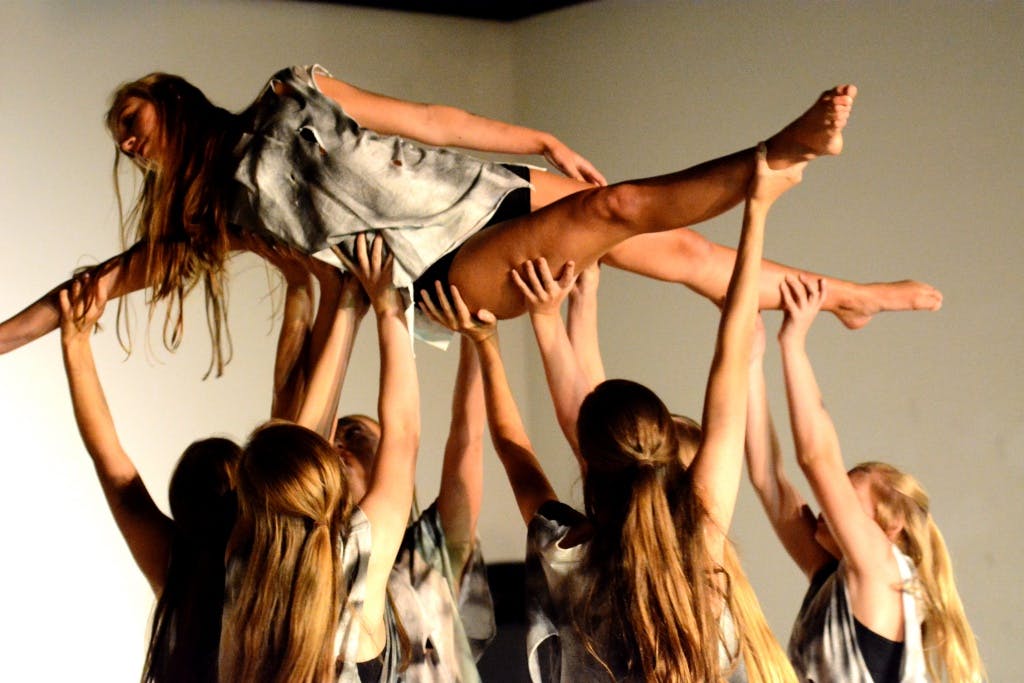Carley Wilson Combines Interests in Dance and Trauma Psychology
Wilmington College senior Carley Wilson recalled back in May the director of the Peace Resource Center saying, “We have this commemoration in August. Do you want to help work on it?”
PICTURED: Members of the Springboro dance company, All That Dance, perform a piece choreographed by WC senior Carley Wilson at the Hiroshima/Nagasaki observance.
As she thought about “the most effective way” of producing a program observing the anniversary of the atomic bombings of Hiroshima and Nagasaki, Wilson knew she wanted to incorporate her love for dance. She wished to share how that expressive art form conveys emotions and human connections in ways other creative media cannot.
Wilson, a psychology major and Spanish minor from Batavia, has a long history as a competitive dancer, which, as a result of being sidelined by an injury at 16, has evolved to include work as a choreographer and training dancers with the company, All That Dance, in Springboro.
“That’s been my primary job for earning money to go to school,” she said.
Wilson became familiar with the story of the atomic bombings in a senior seminar course instructed by PRC director Dr. Tanya Maus, who hired her to work at the Center in May. The atomic bombings by the American military hastened the end of World War II, but left in its wake 250,000 dead and dying Japanese civilians,
“There’s an emotional aspect that had to be told,” she said about the standing-room-only Aug. 9 program at WC, “Never Again: An Atomic Bombing Commemoration.”
“As a country, we sometimes disregard the pain and suffering we’ve inflicted on others,” she added.
Wilson’s primary psychology interest is in the behavior and sensibility associated with trauma, particularly involving those who served in the military. Her academic discipline played a major role in helping her formulate the program.
“My training in psychology helped me build that show,” she said, noting her work with Wilmington psychologist Dr. Bill Kennedy as a mental health specialist intern has complemented her classroom experience. She is looking into pursuing a doctoral program in psychology following her graduation in May 2019.
Wilson and her fellow student collaborators, Maraya Wahl and April Neff, came up with a three-part program featuring “The Moment,” “The Aftermath” and “The Memory.”
Wilson choreographed parts for more than a dozen dancers ages eight through 18.
“Dances were designed to push the audience to look at the true pain and suffering that occurred that day in 1945; another portrayed a mother explaining to her child that bad things happen to good people while others showed the (continuing pain) and that action needs to be taken to prevent this from ever happening again.”
The dances were interspersed with archival footage of the bombing of Hiroshima, poetry readings by WC’s Dr. Bonnie Erwin, assistant professor of English, and a film featuring the story of PRC founding director Barbara Reynolds and her family, who actively protested nuclear weapons testing. Also, four women of Japanese ancestry, known as Harmony of Japan, sang a poignant song of remembrance.
Designed to evoke “feelings of discomfort” among the audience, an 11-minute, time-lapse production, “1945-1998,” combined electronic noises for each nuclear weapons test that occurred from the ever-growing number of nuclear nations over a nearly 50-year period. The 2,053 beeps, blips and buzzes represented 1,032 tests by the United States, 715 by Russia/USSR and 306 by the other members of the “Nuclear Club”: China, Great Britain, France, India and Pakistan.
Wilson said many Americans are unaware or don’t wish to acknowledge that America has conducted the preponderance of nuclear tests — and implemented the only actual wartime use of atomic weapons.
“It’s meant to make you feel uncomfortable,” she said about the piece, also noting that Hillary Hahn’s singing of “What the World Needs Now (Is Love Sweet Love)” was meant to conclude the program with a sense of hopefulness.
“It’s not necessarily meant to end on a happy note, but for us to think about what can be done for a safer world,” she said. “Also, that there can be love and beauty in this world — it can exist. A lot of people seemed really receptive to the message and the call for action. I couldn’t be happier with how things went.”
Wilson lauded Maus for giving her the chance to use her knowledge and creative energies in helping produce such an impactful program.
“It was 100 percent hands-on learning,” she said. “It combined my school life and education with my interest in dance and choreography. It’s such a rarity for students anywhere to have opportunities to do something like this.”
Wilson is the latest member of her family to attend Wilmington College. Others include her parents, Holly Margaritis Wilson ’94 and Donnie Wilson ’90; a brother, Garrett Wilson ’12; and her aunt and uncle, Tim Dicke ’91 and Jill Margaritis Dicke ’92.
“Attending Wilmington College is a family trade,” she said.

Senior Choreographs Poignant Program on A-Bomb Anniversary
Peace Resource Center